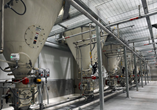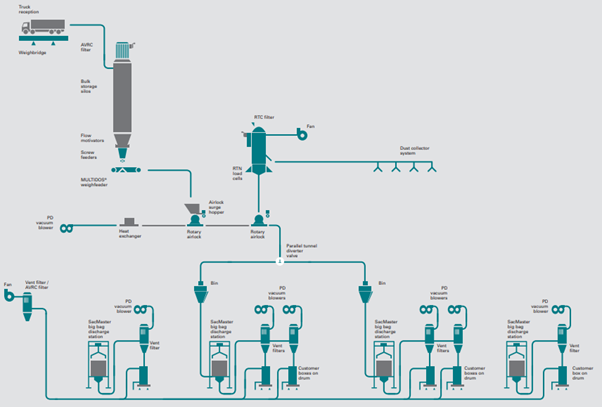In conveying applications, granular sugar can be considered as a difficult-to-handle material. If you have an application involving sugar, it is important to carefully consider your choice of conveying equipment – choosing the wrong equipment can have significant consequences.
In conveying applications, granular sugar can be considered as a difficult-to-handle material. If you have an application involving sugar, it is important to carefully consider your choice of conveying equipment – choosing the wrong equipment can have significant consequences.
Designs that include pneumatic conveying, dust collection, central vacuum systems and integrated explosion protection are helping plants address significant changes in safety directives from government bodies.
OregenPak have several equipment options which have proven success in granular sugar conveying applications. These equipment solutions have been used in multiple installations globally to address the challenges associated with conveying sugar described above.
As a material, granulated or pelletized sugar has the following handling characteristics. First, the material is abrasive, meaning that the conveying equipment has to be capable of withstanding the higher wear imposed on it by sugar granules or pellets. Secondly, sugar is hygroscopic. This means that it readily absorbs moisture, causing the material particles to clump and lump. Thus, depending upon the equipment chosen, flow aids may be necessary to secure successful discharge from the conveyor and ensure a free-flowing supply of material. Thirdly, sugar dust is highly combustible and explosive. Conveying equipment should be capable of preventing fugitive dust emissions and static build-up, while eliminating any possible source of ignition once the material is in the conveyor.
- Pneumatic conveying technologies
Pneumatic conveying has fewer moving parts and greater flexibility for plants with changing needs. Enclosed pipelines protect the material from contamination and virtually eliminate degradation of the product into smaller particles that can present a dust hazard. Pneumatic conveying also integrates filtration while delivering materials to their destination. Sugar refineries are finding they can also utilize this method to increase safety and cleanliness in their facilities.
- Dust collection
It is important that sugar handling facilities employ dust collection systems that are uniquely designed according to plant specifications and also have the benefits of:
a) Limiting emissions
b) Being specifically designed for ease of maintenance
c) Accounting for critical moisture concerns in the environment
d) Including cleanout or inspection opening in ductwork
- Explosion mitigation
There are three primary methods of explosion protection: venting, containment and suppression. Each of these methods of explosion protection offer varying degrees of cost and flexibility depending on the enclosure and its location.
A dust collection system alone does not keep a plant dust-free. Housekeeping must be a part of any good dust collection plan or design. Schenck Process central vacuum systems are an effective way to clean industrial environments that will minimize recontamination and the labor costs of housekeeping.
- Precise feeding
The feeder features the unique ability to disassemble, clean, reconfigure or service from the non-process side. Offered in three model sizes with either a flexible hopper or in all stainless steel, the versatility makes it a favorite for sugar processors.




Sugar Handling General Process

Benefits of Sugar Handling Solution:
* Totally enclosed system
* Smaller footprint
* Significantly minimized degradation
* Few moving parts
* Reduced installation costs
* Lower maintenance costs
Contact: Foster
Phone: 0086-18616029030
E-mail: sales@oregenpak.com
Add: Jiading Zone, Shanghai, P.R.C